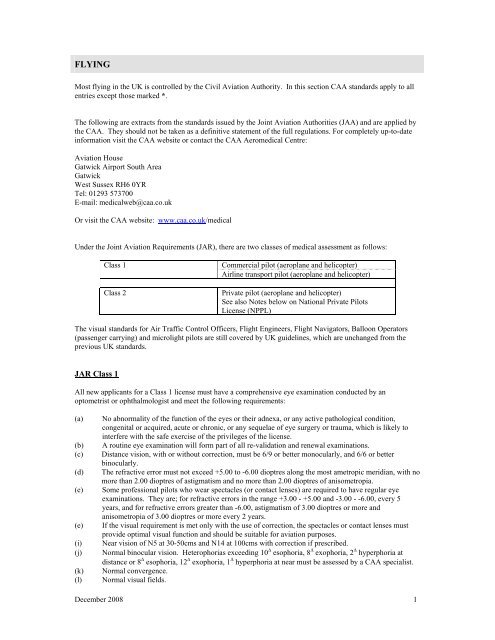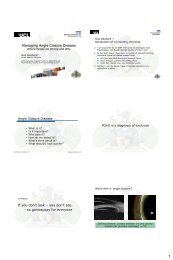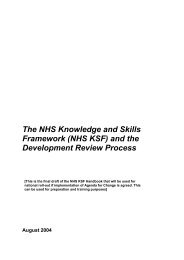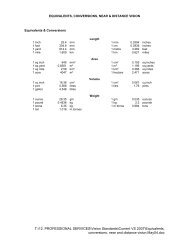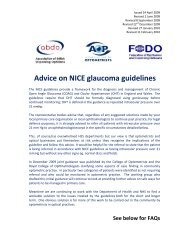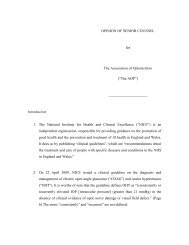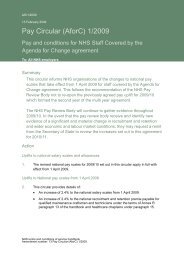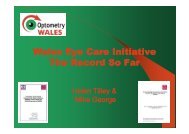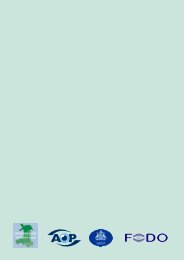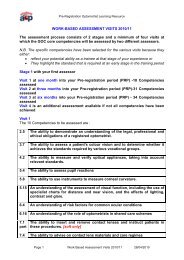CAA vision standards for flying Dec 2008 - Association of Optometrists
CAA vision standards for flying Dec 2008 - Association of Optometrists
CAA vision standards for flying Dec 2008 - Association of Optometrists
Create successful ePaper yourself
Turn your PDF publications into a flip-book with our unique Google optimized e-Paper software.
FLYING<br />
Most <strong>flying</strong> in the UK is controlled by the Civil Aviation Authority. In this section <strong>CAA</strong> <strong>standards</strong> apply to all<br />
entries except those marked *.<br />
The following are extracts from the <strong>standards</strong> issued by the Joint Aviation Authorities (JAA) and are applied by<br />
the <strong>CAA</strong>. They should not be taken as a definitive statement <strong>of</strong> the full regulations. For completely up-to-date<br />
in<strong>for</strong>mation visit the <strong>CAA</strong> website or contact the <strong>CAA</strong> Aeromedical Centre:<br />
Aviation House<br />
Gatwick Airport South Area<br />
Gatwick<br />
West Sussex RH6 0YR<br />
Tel: 01293 573700<br />
E-mail: medicalweb@caa.co.uk<br />
Or visit the <strong>CAA</strong> website: www.caa.co.uk/medical<br />
Under the Joint Aviation Requirements (JAR), there are two classes <strong>of</strong> medical assessment as follows:<br />
Class 1<br />
Class 2<br />
Commercial pilot (aeroplane and helicopter)<br />
Airline transport pilot (aeroplane and helicopter)<br />
Private pilot (aeroplane and helicopter)<br />
See also Notes below on National Private Pilots<br />
License (NPPL)<br />
The visual <strong>standards</strong> <strong>for</strong> Air Traffic Control Officers, Flight Engineers, Flight Navigators, Balloon Operators<br />
(passenger carrying) and microlight pilots are still covered by UK guidelines, which are unchanged from the<br />
previous UK <strong>standards</strong>.<br />
JAR Class 1<br />
All new applicants <strong>for</strong> a Class 1 license must have a comprehensive eye examination conducted by an<br />
optometrist or ophthalmologist and meet the following requirements:<br />
(a)<br />
(b)<br />
(c)<br />
(d)<br />
(e)<br />
(e)<br />
(i)<br />
(j)<br />
(k)<br />
(l)<br />
No abnormality <strong>of</strong> the function <strong>of</strong> the eyes or their adnexa, or any active pathological condition,<br />
congenital or acquired, acute or chronic, or any sequelae <strong>of</strong> eye surgery or trauma, which is likely to<br />
interfere with the safe exercise <strong>of</strong> the privileges <strong>of</strong> the license.<br />
A routine eye examination will <strong>for</strong>m part <strong>of</strong> all re-validation and renewal examinations.<br />
Distance <strong>vision</strong>, with or without correction, must be 6/9 or better monocularly, and 6/6 or better<br />
binocularly.<br />
The refractive error must not exceed +5.00 to -6.00 dioptres along the most ametropic meridian, with no<br />
more than 2.00 dioptres <strong>of</strong> astigmatism and no more than 2.00 dioptres <strong>of</strong> anisometropia.<br />
Some pr<strong>of</strong>essional pilots who wear spectacles (or contact lenses) are required to have regular eye<br />
examinations. They are; <strong>for</strong> refractive errors in the range +3.00 - +5.00 and -3.00 - -6.00, every 5<br />
years, and <strong>for</strong> refractive errors greater than -6.00, astigmatism <strong>of</strong> 3.00 dioptres or more and<br />
anisometropia <strong>of</strong> 3.00 dioptres or more every 2 years.<br />
If the visual requirement is met only with the use <strong>of</strong> correction, the spectacles or contact lenses must<br />
provide optimal visual function and should be suitable <strong>for</strong> aviation purposes.<br />
Near <strong>vision</strong> <strong>of</strong> N5 at 30-50cms and N14 at 100cms with correction if prescribed.<br />
Normal binocular <strong>vision</strong>. Heterophorias exceeding 10 Δ esophoria, 8 Δ exophoria, 2 Δ hyperphoria at<br />
distance or 8 Δ esophoria, 12 Δ exophoria, 1 Δ hyperphoria at near must be assessed by a <strong>CAA</strong> specialist.<br />
Normal convergence.<br />
Normal visual fields.<br />
<strong>Dec</strong>ember <strong>2008</strong> 1
(m)<br />
Normal colours perception (defined as no mistakes on Ishihara plates. Applicants who fail the Ishihara<br />
test will be assessed as colour safe if they pass a suitable lantern test (Holmes-Wright or Beyne<br />
Lantern).<br />
Any spectacles necessary must be ‘available <strong>for</strong> immediate use’, and so there is no time to take them on or <strong>of</strong>f.<br />
An applicant who needs a correction to meet the near visual acuity will require ‘look-over’, or multifocal lenses<br />
in order to read the instruments and a manual held in the hand, and also to make use <strong>of</strong> distance <strong>vision</strong> through<br />
the windscreen without removing the lenses. The <strong>CAA</strong> accepts all <strong>for</strong>ms <strong>of</strong> spectacle correction except that <strong>of</strong> a<br />
single <strong>vision</strong> full lens <strong>for</strong> near.<br />
An applicant is expected to advise the optometrist <strong>of</strong> relevant reading distances <strong>for</strong> the flight deck. The<br />
occupational needs may then be fulfilled by bifocal, trifocal or varifocal lenses. On occasions an intermediate<br />
correction in the upper field may be required, which may be accomplished by a segment <strong>of</strong> the relevant power in<br />
addition to the bifocal or varifocal design. Flip-up spectacles are also acceptable.<br />
Sunglasses may <strong>of</strong>ten be required and their use is encouraged. Tints should be neutral grey, but polarised lenses<br />
and photochromic lenses are discouraged. An additional pair <strong>of</strong> untinted spectacles must be carried.<br />
Contact Lenses<br />
Contact lenses may be worn by a pr<strong>of</strong>essional pilot (but not to correct near <strong>vision</strong>). If contact lenses are worn,<br />
applicants should bring a report from an optometrist to their initial Class 1 medical examination, which includes<br />
the following:<br />
• The contact lens specification and corrected visual acuity;<br />
• Confirmation that the contact lenses have been worn constantly and successfully <strong>for</strong> at least eight hours<br />
a day over a period <strong>of</strong> at least one month.<br />
All gas permeable and hard contact lenses must be removed at least 48 hours be<strong>for</strong>e the initial Class 1 medical<br />
examination, but must be taken to the examination. Multifocal contact lenses or mono<strong>vision</strong> correction are not<br />
acceptable <strong>for</strong> Class 1 certification.<br />
C<br />
Refractive Surgery<br />
The <strong>CAA</strong> does not recommend refractive surgery to gain a medical certificate to fly. The certification limits <strong>of</strong><br />
refractive correction and the limits <strong>of</strong> refraction be<strong>for</strong>e surgery are the same, so it is not possible to gain a<br />
medical certificate by having refractive surgery that it would not have been possible to obtain be<strong>for</strong>e surgery.<br />
However, <strong>for</strong> an applicant who has had refractive surgery, Class 1 certification will be considered three months<br />
after LASIK provided an assessment, including refraction, has been carried out at two months post-operatively.<br />
Certification can be considered six months after LASEK/PRK <strong>for</strong> myopia, provided an assessment has been<br />
carried out three months post-operatively at the Aeromedical Centre. Certification is usually possible one year<br />
after other types <strong>of</strong> surgery. Please note that:<br />
• The pre-operative refraction should not have been more than + 5.00 to -6 dioptres (applicants just<br />
outside this range should contact the <strong>CAA</strong> Medical Department f or advice.)<br />
• an assessment by an eye specialist at the Aeromedical centre will be required<br />
• Stability <strong>of</strong> refraction must be achieved. To show this, applicants will need to obtain a report showing<br />
their refraction about a month be<strong>for</strong>e visiting the Centre.<br />
• There must have no problems with glare<br />
JAR Class 2<br />
All new applicants <strong>for</strong> a Class 1 license must have a comprehensive eye examination conducted by an<br />
optometrist or ophthalmologist and meet the following requirements:<br />
(a)<br />
(b)<br />
(c)<br />
(d)<br />
(i)<br />
No abnormality <strong>of</strong> the function <strong>of</strong> the eyes or their adnexa, or any active pathological condition,<br />
congenital or acquired, acute or chronic, or any sequelae <strong>of</strong> eye surgery or trauma, which is likely to<br />
interfere with the safe exercise <strong>of</strong> the privileges <strong>of</strong> the applicable license.<br />
Distance <strong>vision</strong>, with or without correction, must be 6/12 or better monocularly, and 6/6 or better<br />
binocularly.<br />
If the visual requirement is met only with the use <strong>of</strong> correction, the spectacles or contact lenses must<br />
provide optimal visual function and should be suitable <strong>for</strong> aviation purposes.<br />
The refractive error must not exceed +5.00 and -8.00 dioptres along the most ametropic meridian, with<br />
no more than +/-3.00 dioptres astigmatic component and no more than 3.00 dioptres <strong>of</strong> anisometropia.<br />
Near <strong>vision</strong> <strong>of</strong> N5 at 30-50cms and N14 at 100cms with correction if prescribed.<br />
<strong>Dec</strong>ember <strong>2008</strong> 2
(j)<br />
(k)<br />
(l)<br />
(m)<br />
(n)<br />
No diplopia. A binocular <strong>vision</strong> abnormality such as a squint may need specialist assessment.<br />
In an applicant with amblyopia, the visual acuity <strong>of</strong> the amblyopic eye must be 6/18 or better and the<br />
<strong>vision</strong> in the other eye is 6/6 or better with correction if necessary.<br />
Normal visual fields.<br />
Normal colour perception defined as no mistakes on Ishihara plates. Applicants who fail the Ishihara<br />
test can still gain a Class 2 certificate, but limited to daylight <strong>flying</strong> only. This limitation can be<br />
removed if an approved lantern test (Holmes-Wright or Beyne Lantern) is passed. An applicant wishing<br />
to take a lantern test should contact the Aeromedical Centre <strong>for</strong> details <strong>of</strong> their nearest lantern.<br />
An applicant who has not met the colour <strong>vision</strong> requirement may still fly using a National Private Pilots<br />
License (see below).<br />
Any spectacles necessary must be ‘available <strong>for</strong> immediate use’, and so there is no time to take them on or <strong>of</strong>f.<br />
An applicant who needs a correction to meet the near visual acuity will require ‘look-over’, or multifocal lenses<br />
in order to read the instruments and a manual held in the hand, and also to make use <strong>of</strong> distance <strong>vision</strong> through<br />
the windscreen without removing the lenses. The <strong>CAA</strong> does not proscribe any type <strong>of</strong> visual correction except a<br />
single <strong>vision</strong> full lens near correction. All types <strong>of</strong> contact lenses except bifocal are permissible.<br />
An applicant is expected to advise the optometrist <strong>of</strong> relevant reading distances <strong>for</strong> the flight deck. The<br />
occupational needs may then be fulfilled by bifocal, trifocal or varifocal lenses. On occasions an intermediate<br />
correction in the upper field may be required, which may be accomplished by a segment <strong>of</strong> the relevant power in<br />
addition to the bifocal or varifocal design. Flip-up spectacles are also acceptable.<br />
Sunglasses may <strong>of</strong>ten be required and their use is encouraged. Tints should be neutral grey, but polarised lenses<br />
and photochromic lenses are discouraged. An additional pair <strong>of</strong> untinted spectacles must be carried.<br />
Contact Lenses<br />
Contact lenses may be worn as a student or private pilot (but not to correct near <strong>vision</strong>). If contact lenses are<br />
worn applicants should bring a report from an optometrist to their initial Class 2 medical examination, which<br />
must include the following:<br />
• the contact lens specification and corrected visual acuity;<br />
• Confirmation that the contact lenses have been worn constantly and successfully <strong>for</strong> over eight hours a<br />
day over a period <strong>of</strong> at least one month.<br />
All gas permeable and hard contact lenses must be removed at least 48 hours be<strong>for</strong>e the initial Class 2 medical<br />
examination. Any contact lenses should be brought to the examination. Multifocal contact lenses or mono<strong>vision</strong><br />
correction are not acceptable <strong>for</strong> Class 2 certification.<br />
Refractive Surgery<br />
The <strong>CAA</strong> does not recommend refractive surgery to gain a medical certificate to fly. The certification limits <strong>of</strong><br />
refractive correction and the limits <strong>of</strong> refraction be<strong>for</strong>e surgery are the same, so it is not possible to gain a<br />
medical certificate by having refractive surgery that it would not have been possible to obtain be<strong>for</strong>e surgery.<br />
However, <strong>for</strong> an applicant who has had refractive surgery, Class 2 certification will be considered three months<br />
after LASIK provided an assessment, including refraction, has been carried out at two months post-operatively.<br />
Certification can be considered six months after LASEK/PRK <strong>for</strong> myopia, provided an assessment has been<br />
carried out three months post-operatively. Certification is usually possible one year after other types <strong>of</strong> surgery.<br />
Please note that:<br />
• The pre-operative refraction must not have exceeded +5 and -8<br />
• An assessment by an eye specialist will be required.<br />
• Stability <strong>of</strong> refraction must be achieved. To show this, applicants will need to obtain a report showing<br />
their refraction about a month be<strong>for</strong>e the medical exam.<br />
• There must have no problems with glare.<br />
Air Traffic Control Officers<br />
Air Traffic Controller Officers initial examination is the same as JAR Class 1 (but Air Traffic Control<br />
applicants should contact the <strong>CAA</strong> Aeromedical Centre or NATS <strong>for</strong> exact requirements). The NATS<br />
publish the following requirements:<br />
• Candidates must have normal colour <strong>vision</strong>.<br />
• Visual acuity must be 6/9 or better in each eye.<br />
<strong>Dec</strong>ember <strong>2008</strong> 3
• Refractive correction must not exceed +3.00 or – 3.00 dioptres spherical error in each eye.<br />
Cylindrical correction shall not exceed 2 dioptres in each eye; anisometropia shall not exceed<br />
2 dioptres.<br />
• For applicants aged 26 and over, the correction allowed will be considered on an individual<br />
basis. It must not exceed <strong>standards</strong> set by the Civil Aviation Authority (<strong>CAA</strong>).<br />
• If you have had any <strong>for</strong>m <strong>of</strong> eye surgery, to include, squint correction, laser visual correction ,<br />
even if the pre-operative correction is within the NATS acceptable range, applicants will be<br />
referred to a specialist appointed by NATS <strong>for</strong> further examination.<br />
• Pre-operative refractive corrections outside <strong>of</strong> the stated NATS eyesight limit, but within the<br />
<strong>CAA</strong> limits (+5.00 and -6.00), will be considered on a one to one basis.<br />
Non-Pilot Flight Crew (Flight Engineers, Flight Navigators)<br />
The visual requirements are generally the same as <strong>for</strong> JAR Class 1 certification:<br />
Balloon/Airship Pilots<br />
Balloon and airship pilots have previously required a UK national medical certificate to fly; these are no longer<br />
issued. When a medical certificate expires or when a student pilot starts <strong>flying</strong>, the medical requirements <strong>for</strong><br />
these pilots will either be to the JAR Class 2 or to the National PPL DVLA driving medical <strong>standards</strong> according<br />
to the following table:.<br />
Commercial Balloon/Airship license (including JAR Class 2<br />
balloon passenger transportation)<br />
Commercial Balloon license (restricted aerial work) NPPL (DVLA Class 2)<br />
Private Balloon/Airship license NPPL (DVLA Class 1 or 2)<br />
National Private Pilots License (NPPL)<br />
This license is easier to obtain and easier to maintain than the standard JAR private pilots license and is intended<br />
to cover recreational <strong>flying</strong>. The regulation <strong>of</strong> the license is devolved to a number <strong>of</strong> ‘Air Sports’ governing<br />
bodies and includes single engine piston aircraft, self-launching motor gliders and microlight aircraft. All <strong>flying</strong><br />
under this license is restricted to daylight hours and Visual Flying Rules (VFR) only.<br />
The <strong>vision</strong> standard is based on the DVLA <strong>vision</strong> <strong>standards</strong> <strong>for</strong> drivers <strong>of</strong> motor vehicles and certification is<br />
done by GPs. These DVLA <strong>vision</strong> <strong>standards</strong> are laid out detail in the section on motor vehicle drivers, and on<br />
the DVLA website. All the visual disorders listed by the DVLA in “At a Glance” are included within these<br />
requirements. There is no colour <strong>vision</strong> requirement.<br />
To fly solo or with qualified safety pilot the applicant must meet the DVLA Group 1 requirements (normal car<br />
license).<br />
To carry passengers, the applicant must meet the DVLA Group 2 requirements (LGV and PCV etc). There are 2<br />
<strong>of</strong> the Group 2 requirements which are slightly amended <strong>for</strong> NPPL:-<br />
1) There is no unaided <strong>vision</strong> standard <strong>of</strong> 3/60 required <strong>for</strong> NPPL<br />
<strong>Dec</strong>ember <strong>2008</strong> 4
2) Monocularity is not a bar to <strong>flying</strong> but initially monocular pilots should be assessed as fit <strong>for</strong> solo/safety<br />
pilot <strong>flying</strong> only (Group 1). However if they pass an operational assessment (by their <strong>flying</strong> instructor)<br />
at the end <strong>of</strong> training, they may be upgraded to an unrestricted NPPL to carry passengers.<br />
Gliders*<br />
In the UK, the <strong>CAA</strong> has delegated control <strong>of</strong> all aspects <strong>of</strong> gliding to the British Gliding <strong>Association</strong>. The<br />
following there<strong>for</strong>e are their regulations, not <strong>CAA</strong>. However, this standard is the same as the NPPL standard<br />
above.<br />
• To fly gliders solo the pilot must meet the <strong>standards</strong> laid down <strong>for</strong> driving a car.<br />
• For other instructional <strong>flying</strong> and carrying passengers, the DVLA Group 2 visual <strong>standards</strong> must be met<br />
with the exceptions that monocularity is acceptable and there is unaided <strong>vision</strong> requirement.<br />
• For pr<strong>of</strong>essional instructional <strong>flying</strong>, JAR Class 2 <strong>standards</strong> <strong>of</strong> medical fitness should be met.<br />
• Modern contact lenses are compatible with gliding;<br />
• Colour <strong>vision</strong> defects are not a bar as coloured lights are not used to control gliding operations;<br />
• Monocularity, when adapted, is not disbarring;<br />
• Deteriorating visual acuity with age may require termination <strong>of</strong> <strong>flying</strong>, but this will be based on <strong>flying</strong><br />
per<strong>for</strong>mance rather than set acuity levels.<br />
• Pilots who wear spectacles should equip themselves with a spare pair, and should have both clear and tinted<br />
pairs <strong>of</strong> good quality, which give a wide field <strong>of</strong> view.<br />
Hang-gliding & Para-gliding*<br />
The British Hang Gliding & Paragliding <strong>Association</strong> recommends that Polycarbonate lenses are used, but no<br />
eyesight <strong>standards</strong> apply.<br />
Other Occupations<br />
Fire crew<br />
The following minimum <strong>standards</strong> apply:<br />
a<br />
b<br />
c<br />
d<br />
e<br />
Distance visual acuity should not be less than 6/12 in one eye and 6/36 in the other, with glasses if<br />
necessary, and not less than 6/18 with both eyes unaided.<br />
Where spectacles are required to achieve the above standard, <strong>for</strong> operational duties they should be <strong>of</strong> a<br />
safety type approved by the Authority.<br />
The use <strong>of</strong> contact lenses is not permitted.<br />
Colour perception should be normal on initial testing by Ishihara plates. If a defect is found during the<br />
examination, a further test is to be carried out using a suitable lantern to demonstrate the ability to<br />
distinguish the signal colour red, green and white.<br />
Where the fire-fighter’s duties require the holding <strong>of</strong> a Heavy Goods Vehicle Licence (HGV) the<br />
appropriate DVLC <strong>standards</strong> and examination recommendations will apply.<br />
Airside Drivers<br />
a<br />
b<br />
Eyesight <strong>standards</strong> required are DVLA Group 2 standard plus-<br />
Colour perception should be normal on initial testing by Ishihara plates. If a defect is found during the<br />
examination, a further test is to be carried out using a suitable lantern to demonstrate the ability to<br />
distinguish the signal colour red, green and white (Giles-Archer lantern on large aperture).<br />
RVR Observers (lighting panel operators)<br />
a<br />
Personnel selected <strong>for</strong> RVR observer should have examination per<strong>for</strong>med:<br />
1 Prior to acceptance <strong>for</strong> RVR duties<br />
2 5-yearly up to 40, then 2-yearly to 50, then annually thereafter<br />
3 be<strong>for</strong>e return to duty following any sickness involving eyesight<br />
<strong>Dec</strong>ember <strong>2008</strong> 5
c<br />
d<br />
e<br />
f<br />
Visual Acuity in each eye separately must be not less than 6/9 at distance using Snellen Test Types. If<br />
correcting spectacles or contact lenses are worn, the refractive error should not exceed +/-5.00 dioptres <strong>of</strong><br />
equivalent spherical error.<br />
The near <strong>vision</strong> should be N5 or equivalent at a distance between 30 and 50cm in each eye separately.<br />
Spectacles may be worn to achieve this standard.<br />
The visual fields shall be normal as tested by the confrontation method.<br />
The ocular muscle balance should be normal.<br />
Colour perception should be tested by Ishihara or other pseudoisochromatic colour plates. Candidates who<br />
are shown to be defective by this means should be subjected to an approved lantern test, e.g. Giles-Archer<br />
or Holmes-Wright, to demonstrate that the colours signal red, signal green and white can be readily<br />
identified. Colour perception testing should not be repeated at the periodic <strong>vision</strong> testing.<br />
<strong>Dec</strong>ember <strong>2008</strong> 6


